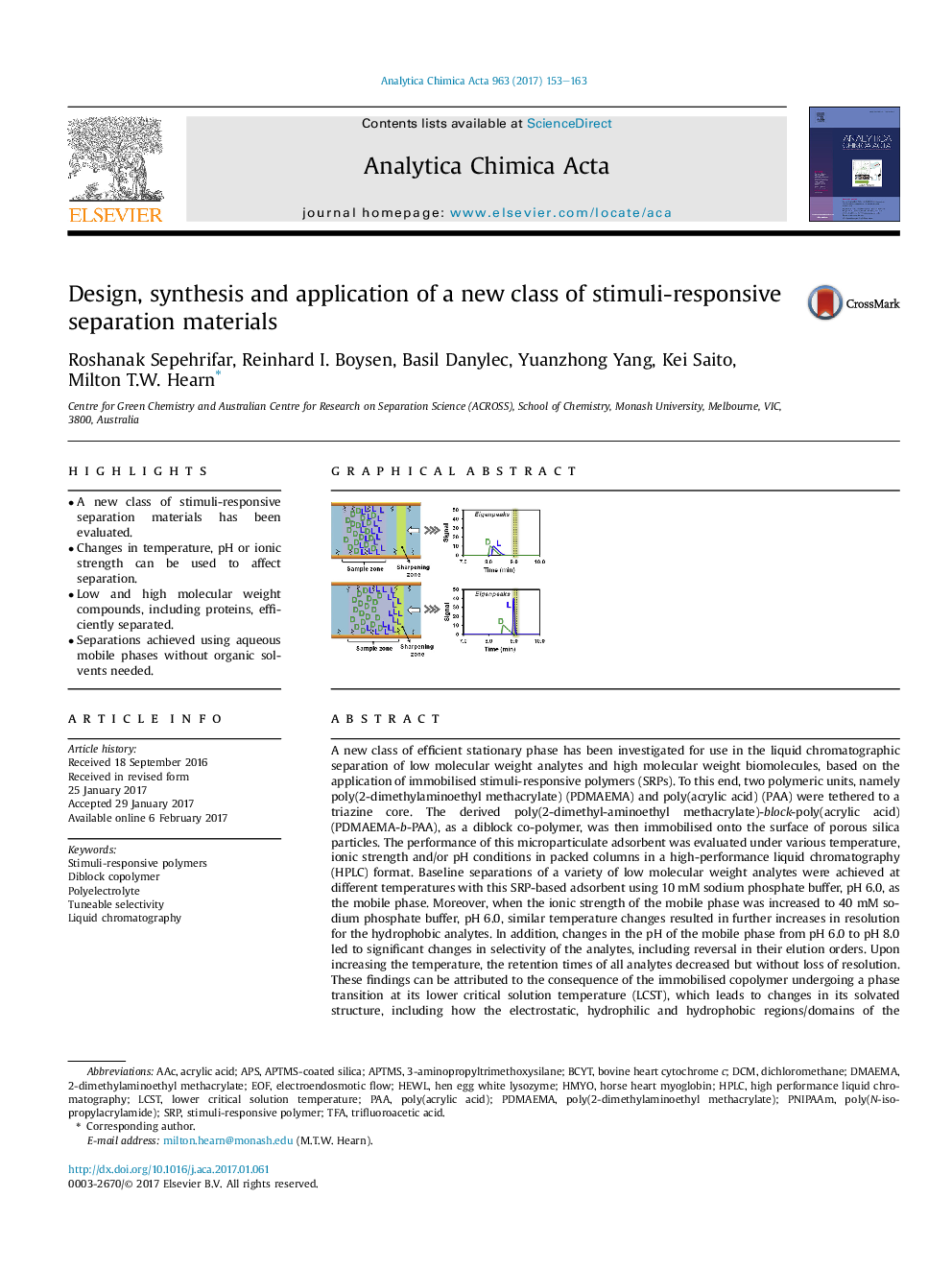| کد مقاله | کد نشریه | سال انتشار | مقاله انگلیسی | نسخه تمام متن |
|---|---|---|---|---|
| 5130928 | 1490869 | 2017 | 11 صفحه PDF | دانلود رایگان |

- A new class of stimuli-responsive separation materials has been evaluated.
- Changes in temperature, pH or ionic strength can be used to affect separation.
- Low and high molecular weight compounds, including proteins, efficiently separated.
- Separations achieved using aqueous mobile phases without organic solvents needed.
A new class of efficient stationary phase has been investigated for use in the liquid chromatographic separation of low molecular weight analytes and high molecular weight biomolecules, based on the application of immobilised stimuli-responsive polymers (SRPs). To this end, two polymeric units, namely poly(2-dimethylaminoethyl methacrylate) (PDMAEMA) and poly(acrylic acid) (PAA) were tethered to a triazine core. The derived poly(2-dimethyl-aminoethyl methacrylate)-block-poly(acrylic acid) (PDMAEMA-b-PAA), as a diblock co-polymer, was then immobilised onto the surface of porous silica particles. The performance of this microparticulate adsorbent was evaluated under various temperature, ionic strength and/or pH conditions in packed columns in a high-performance liquid chromatography (HPLC) format. Baseline separations of a variety of low molecular weight analytes were achieved at different temperatures with this SRP-based adsorbent using 10Â mM sodium phosphate buffer, pH 6.0, as the mobile phase. Moreover, when the ionic strength of the mobile phase was increased to 40Â mM sodium phosphate buffer, pH 6.0, similar temperature changes resulted in further increases in resolution for the hydrophobic analytes. In addition, changes in the pH of the mobile phase from pH 6.0 to pH 8.0 led to significant changes in selectivity of the analytes, including reversal in their elution orders. Upon increasing the temperature, the retention times of all analytes decreased but without loss of resolution. These findings can be attributed to the consequence of the immobilised copolymer undergoing a phase transition at its lower critical solution temperature (LCST), which leads to changes in its solvated structure, including how the electrostatic, hydrophilic and hydrophobic regions/domains of the copolymer are exposed to the bulk mobile phase. Thermodynamic data were indicative of a temperature-related re-organisation of the structure of the immobilised PDMAEMA-b-PAA stationary phase with exothermic binding of the analytes occurring at temperatures below the lower critical solution temperature (LCST). In this manner; changes in the system temperature could directly be used to manipulate the adsorption and desorption behaviour of these analytes with this stimuli-responsive, polymer-modified porous silica stationary phase. Additional studies with several proteins further documented the versatility of these stimuli-responsive separation materials. The results indicated that these separations could be tuned by variation of the temperature with fully aqueous mobile phases at specific ionic strength and pH values, without the need to use an organic solvent as a component in the mobile phase.
200
Journal: Analytica Chimica Acta - Volume 963, 22 April 2017, Pages 153-163